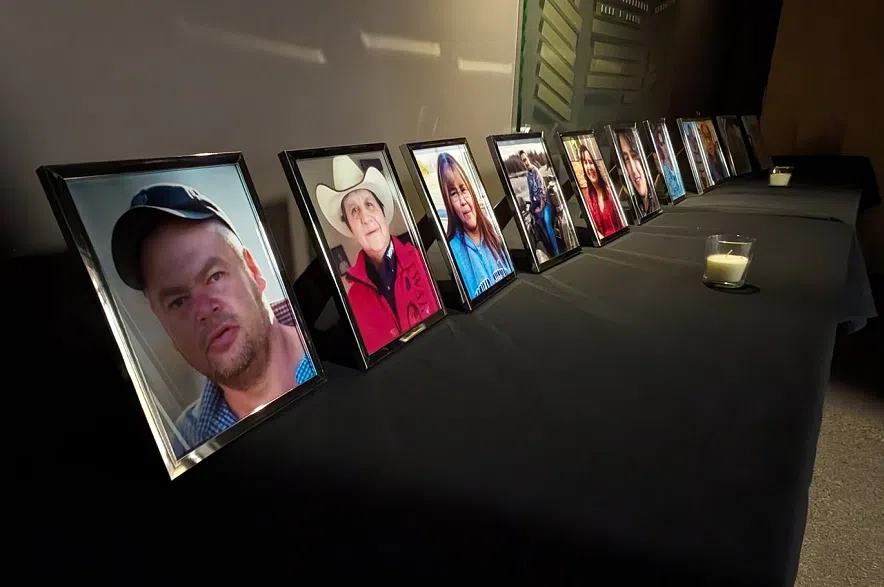A psychologist contracted by Correctional Service Canada offered a heartfelt apology to conclude his testimony Thursday at the inquest into the mass murders on the James Smith Cree Nation and in Weldon.
David McGale told those present for Day 9 of the inquest in Melfort that he’s sorry for the pain and suffering families have gone through since Myles Sanderson killed 11 people and injured 17 others on Sept. 4, 2022.
“I wish I could have (fore)seen something like this to happen, but unfortunately I couldn’t,” McGale said.
Earlier, McGale testified that a violence risk appraisal guide he put Sanderson through in prison determined he was a high risk to reoffend violently after his release.
Based on Sanderson’s score, McGale said, the inmate had a 55 per cent probability of violent recidivism in the first five years after his release and a 60 per cent probability in the 10 years following his release.
Having said that, McGale also noted those tools need to be paired with professional understanding and opinion because the assessments can be put on someone who has been out of prison for 20 years and hasn’t reoffended, and it would still show them as a high risk.
His final conclusion was that Sanderson was a moderate risk for general and domestic violence recidivism. McGale said he supported any bid Sanderson put in for parole, as long as he continued with his good behaviour and work.
McGale testified that during a 2 1/2-hour interview for a psychological assessment, Sanderson took responsibility for the offences he previously had committed and said they were associated with substance use.
The inmate said he regretted his actions because of the harm he had caused others, particularly those he was supposed to love.
McGale recalled Sanderson talking about his childhood and the abuse and neglect he suffered, and how it played a part in his problems. McGale said that showed self-awareness on Sanderson’s part, but he couldn’t say whether that came from Sanderson himself or the programming he already had taken.
But in a level of service inventory assessment he did on Sanderson, McGale found the inmate to be a medium-high risk to reoffend – 57 per cent likely, according to the assessment — in the first year after his release.
McGale noted that could just be a breach of release conditions instead of a criminal offence.
The psychologist was asked if the kind of extreme violence Sanderson committed in September of 2022 would have been identified in his reports and assessments. He replied there wasn’t any indication that Sanderson was going to go out and do what he did, because he wasn’t talking about grudges or vendettas.
The psychologist said everything Sanderson was doing in custody was positive and would have mitigated his risk. McGale believes Sanderson relapsed into substance abuse and had relationship issues and that’s what took him off track.
“I don’t know what we could have done differently with his case, based on what I know,” McGale testified.
READ MORE:
- Day 1: Jury selection, first witness at James Smith Cree Nation inquest
- Day 2: Emotions intensify as testimony continues at JSCN inquest
- Day 3: RCMP witness at JSCN inquest discusses drug trade, warrants
- Day 4: RCMP witness apologizes to veteran’s family at JSCN inquest
- Day 5: Psychologist shares assessment of Myles Sanderson at JSCN inquest
- Day 6: Inquest hears Sanderson wasn’t among Sask.’s most wanted before attacks
- Day 7: Sanderson’s release from custody scrutinized at JSCN inquiry
- Day 8: Parole officers, program facilitator detail Sanderson’s progress in prison
Psychiatrist who met Sanderson testifies
Dr. Jeffrey Waldman, a registered psychiatrist contracted by Correctional Service Canada, saw Sanderson once during his time in prison, in August of 2020.
Waldman, who has been doing correctional psychiatry work for the past six years, described a less-than-perfect system for psychiatry within correctional facilities. He talked about some confusion around charting and referrals, a lack of consistency in some cases, and low resources that could result in inmates not getting the kind of help that would really benefit them.
Waldman said many inmates with the same risk of substance abuse as Sanderson and a similar history of childhood abuse and neglect could do what he did, so those people need to be identified and their treatment taken seriously.
The psychiatrist also outlined the different psychotropic medications — those that affect a person’s mental state — that were prescribed to Sanderson, including an antidepressant, another antidepressant for sleep and an ADHD medication.
There weren’t any anti-psychotics prescribed, though Sanderson told officials when he arrived in prison that he previously had been given an antipsychotic.
Waldman testified that a report showed Sanderson had been diagnosed with oppositional defiant disorder as a youngster, chronic post-traumatic stress disorder, a chronic depressive disorder, an antisocial personality disorder and ADHD.
The witness said substance use disorders and addictions are difficult to treat – and trying to do so in a highly stressful or dangerous environment like a maximum-security prison is not ideal.
Pathologist provides details of six autopsies
The testimony of a pathologist who conducted autopsies on six of the victims produced an emotional Thursday morning at the inquest.
Dr. Derek Musgrove — who did the autopsies on Bonnie Burns, Gregory Burns, Lydia Gloria Burns, Christian Head, Lana Head and Damien Sanderson — detailed for the inquest the nature of the injuries those people suffered at Myles Sanderson’s hands.
980 CJME is not reporting all of the details of Musgrove’s testimony due to their graphic nature. He provided information about each person’s stab wounds and the amount of time it likely took them to succumb to those injuries.
In four of the cases, Musgrove estimated the victim died within two to 10 minutes of being stabbed.
The pathologist said Damien Sanderson, whose body was found in the grass beside a road on the Cree Nation, could have died within minutes of being stabbed by his brother – or he could have survived for more than an hour. Musgrove wasn’t able to narrow down a time of death in that case.
Musgrove testified Christian Head’s injuries could have taken his life almost immediately.
The pathologist also noted that Lydia Gloria Burns was the only victim who didn’t have multiple stab wounds.
The detailed, stark evidence was difficult for some people at the inquest to hear. A couple of people had to leave the room and could be seen comforting each other during the breaks.
The presiding coroner made a point of taking breaks between every two autopsy reports to give everyone in the room time to recover. Representatives for the families didn’t ask the pathologist any questions.
Given that the James Smith Cree Nation is about 20 minutes away from the nearest hospital, Musgrove said it’s unlikely the victims he examined would have been saved by an ambulance that would have had to make a 40-minute round trip.
On Friday, Dr. Shaun Ladham is slated to testify about the autopsies he performed on Robert Sanderson, Carol Burns, Thomas Burns, Earl Burns and Wesley Petterson.
— With files from 980 CJME’s Lisa Schick











